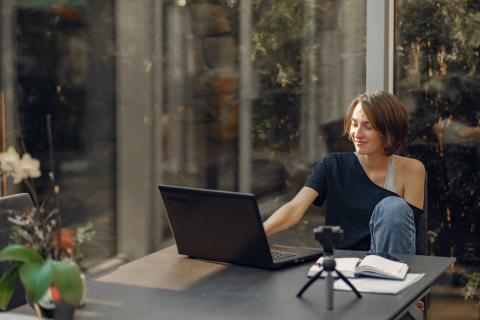How Can Employers Ensure A Safe Return To Work?

COVID-19 has put the global economy under huge pressure and has dramatically changed working life as it was previously known for most professionals around the world. Whether it has been adapting to working from home, holding/attending interviews using video conferencing tools, or keeping remotely based employees engaged and productive, we’ve all had to adjust our daily routines without much warning. But now, many businesses are thinking about how they can safely return to work.
IMPORTANT TO REMEMBER: Check your national health authority website for the latest and most comprehensive guidelines relevant to your business.
With the infection rate easing off in a number of countries and a gradual relaxation of restrictions, it’s inevitable that businesses will want to properly get going again. First of all, you must weigh up whether it’s truly worthwhile for your employees to return to work - with restrictive policy measures around social distancing in place, will the office be a more productive environment than working from home?
Skip to:
- 4 steps to consider when reopening your office
- The importance of your HR department
- 14 steps you can implement to make your office safe for employees
- A futuristic approach to new offices
- How our Shanghai office conducted their return to work
- Why you should be mindful of employees as individuals
If you do decide that a return to the office is necessary for your business, it is likely to be a phased return, in a step-by-step approach, and over a prolonged period of time. Above all, the greatest emphasis should be placed on how you take care of your employees, paying close attention to their health and wellbeing.
4 steps to consider when reopening your office
1. Empower a COVID-19 ‘task force’ team consisting of individuals from across your business. This diversity of individuals is important as it enables the team to manage the inevitable wide range of details like workplace logistics and employee communications.
2. Look at the regional data around infection rates as this will give you a much more accurate, local understanding of the risks. Clearly outlining and visualising this will help ease any concerns your employees may have.
3. The layout of your workspace will most likely have to change.

Ken Flerlage from Tableau explored how data can be used to visualise how office space should be set up to ensure social distancing. You will have to set strict parameters and guidelines so that it is clear for your employees.
4. Monitor the mental health and wellness of your employees to get an accurate gauge of how they are feeling about returning to work. Running surveys is an effective way of getting honest responses and once these results have been gathered, analysing the findings will help you develop important metrics around how to take action against the impacts on your team members.
The vital role HR will play when you return to work
HR professionals and departments all over the world have been incredibly busy since the outbreak of the COVID-19 crisis; regularly updating policies and constantly supporting leadership teams when making key decisions. This busy period will continue as employees start to return to the office - HR teams will need to understand the problems facing the workforce and their concerns around being in the workplace or commuting.
The key to success when reintroducing employees to the office is education and communication.
It is understandable that many of your team members may well be fearful of going back to work after quarantine or lockdown. Alongside your HR team, you need to not only help individuals overcome any concerns they may have, but also encourage them to recognise there is an element of risk too. Both can be accomplished through training programs, educating your staff on how best to reduce the risks to themselves and their colleagues.
But it’s not just the addressing of fears and concerns which is important. It’s just as vital that you educate your staff about the benefits of getting back to work as well. Many people may have had their idealistic view of working from home altered slightly (or significantly) and will now be eager to get back into the daily routine of working in an office - from the enjoyment of interacting with colleagues right down to coping with the previously dreaded commute!
Return to work plan: How can you adapt your office?
For those organisations planning a return to work, minimising virus transmission in the office is now a vital consideration; employers will have to adapt their offices to comply with the social distancing guidance outlined by relevant governing bodies in order to make the workplace as safe as possible.
Which of the 14 steps outlined below could you take so as to reduce the risk of virus transmission between employees in the workplace?
- Encourage people to avoid public transport when commuting - if employees can walk, cycle or drive to work, this substantially minimises the risk of transmission
- Introduce a minimum area per person within the office to decrease density - increase the size of desks to spread staff apart
- Distribute paper placemats for each desk which can be thrown away at the end of each day and replaced the next morning
- Where possible, encourage employees to take the stairs rather than using shared lifts
- Supply PPE and train employees on how to appropriately use it
- Increase frequency of deep cleaning
- Make wearing face masks mandatory for all employees when in the office
- Create alcohol gel cleaning stations to be utilised upon entry
- Enforce a ‘maximum occupancy’ number for lifts and lobbies to prevent overcrowding in closed areas
- Temporarily close communal areas such as kitchens and break rooms where numerous people are likely to be touching surfaces
- Introduce staggered work patterns across teams to keep employee density low - encourage people to work from home (where possible) several times per week and adjust start/finish times so not everyone arrives at once
- Increase ventilation levels with more windows open
- Create visual instructions and prompts (circles around desks, lanes in corridors, standing spots in lifts etc.) to reinforce social distancing around the office
- Implement one-way walking flows to restrict unnecessary contact
By taking active steps to reduce the risk of transmission at work, you are not only protecting the health and wellbeing of your staff but you’re also displaying that you care, which is an important contributing factor to better engagement and increased retention rates.

Some organisations are already preparing their offices for the future
Whilst most of the above steps are relatively easy to implement and won’t be too costly, some companies are making significant investments to update and adapt their offices, essentially future-proofing against any subsequent outbreaks. For example, by moving away from open-plan layouts, widening corridors and increasing the size of doorways.
This said, the most likely area of investment will be in new contactless technologies which reduce disease transmission on frequently touched surfaces...
A waste management company based in Sharjah, UAE, planned to have contactless pathways implemented within its new HQ before the COVID-19 outbreak, meaning their employees will very rarely need to touch shared surfaces in the building. Motion sensors and facial recognition technology automatically open office doors, whilst smartphone apps allow employees to call lifts and even order coffee.
Due to the fact that 80% of infectious diseases are transmitted when surfaces are touched, this hands-free future seems likely to become even more common now!
An insight from our office in Shanghai...
Here is a brief summary from one of our employees based in Shanghai, outlining the measures they have taken to mitigate the risk of transmission upon their return to work.
"When we got back to the office, our communal pantry was out of service. Everyone is having lunch at their own desks rather than in the ‘break area’ and for using the lifts, there is a strict maximum limit of 6 people per ride. Also, we went back to the office on a phased return, 1/3 per week and we will have around 2-3 further months of flexible working hours to avoid everyone arriving at the office during the morning rush hour."
Would some staff members prefer to work from home?
Most of the information above has been based on the premise that you and your employees are planning a return to the office, albeit gradually. In reality, that might not be the best approach for all of your team members.
If an employee is more at risk, regularly in contact with someone at risk or just fearful of returning to the office, continuing to work from home may be the better solution for them. In this case, is there anything extra you can do to help support their remote working? Could you contribute towards a proper desk set-up and office chair?
If this is going to become a long-term solution for a number of your employees, their homes will need to be adapted to better accommodate working practices - and it would be great if you could help them out!
You need to be mindful of your individual employees

Every business will have different needs and each individual within your workforce will have varied feelings, both positive and negative, about a return to work after COVID-19. It is your duty as an employer to take a strategic approach and account for their needs, and conversely, it’s important for them to understand that they will have to accommodate your suggestions.
Obviously, those employees who are classified as a ‘high risk’ individual or share a home with someone who is vulnerable should, where possible, continue to fully work from home. In this scenario, it is important to be empathetic and supportive.
Both sides will have to be flexible and employers should continue to adapt policies as the situation progresses so that any issues can be addressed in a timely fashion. More than anything, it’s vital that there is a clear dialogue which allows concerns to be raised and for worries to be taken into account.
After all, no employer wants to put its staff at unnecessary risk!











